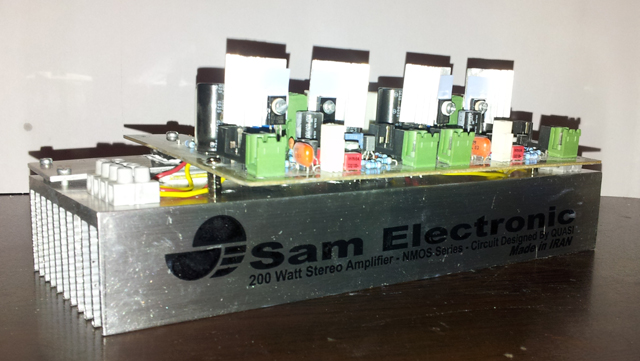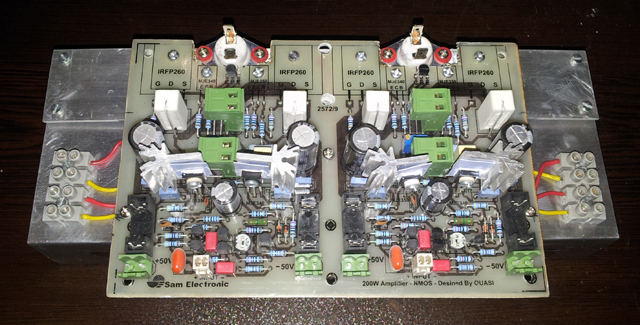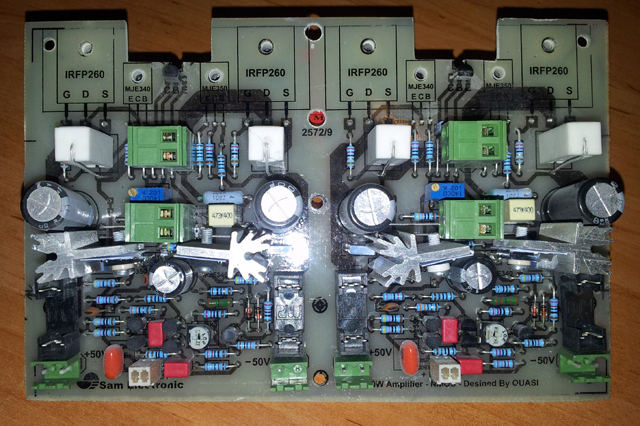1. You can use 2 pairs, but you have to connect them with wires and add rezistors. But you can simply build Nmos 350 and only mount 2 pairs like I did.hi guys !
this is my first post in this forum 😱
i want to build nmos200-TO247 version but before building i have a few questions :
1.can i use 2 pairs of irfp260 fets in this amp instead of one pair ? (for driving 4Ohm speaker) how should i connect them ?
2.what was the final decision about using an amber LED instead of r21 in this circuit ? does it improve sound quality ?
3.can i use 2sd669/2sb649 instead of mje340/350?
4.can i use 2n5401 instead of bc556 ?
forgive me for my poor english ..
cheers
2. I don`t know, I build Nmos 350 and I kept everything like in schematic.
3. Most likely you can use 2sd669/2sb649, but try not go over +/-60v dc for 2sd669/2sb649 and +/-80v dc for 2sd669A/2sb649A
4. Yes and watch out for pinouts.
Good luck.
hi guys !
this is my first post in this forum 😱
i want to build nmos200-TO247 version but before building i have a few questions :
1.can i use 2 pairs of irfp260 fets in this amp instead of one pair ? (for driving 4Ohm speaker) how should i connect them ? -- offcouse can use everyone you have ( just care Vgs)
2.what was the final decision about using an amber LED instead of r21 in this circuit ? does it improve sound quality ? offcouse they 've ready tested it .. see also Nmos page .
3.can i use 2sd669/2sb649 instead of mje340/350? the same item1
4.can i use 2n5401 instead of bc556 ? the same item1
thank you very much for your answers
i asked those questions to make sure because i cant find the original transistors of this circuit with a good quality
i have only one more question then i will go to build it :
can i use 2sk1058 with nmos 200 ?
thanks again
cheers
i asked those questions to make sure because i cant find the original transistors of this circuit with a good quality
i have only one more question then i will go to build it :
can i use 2sk1058 with nmos 200 ?
thanks again
cheers
It means they are different from Vertical mosFETs.
The amplifier was designed to work with the specified parts.
You are out on a limb if you substitute different parts.
The amplifier was designed to work with the specified parts.
You are out on a limb if you substitute different parts.
ok thank you AndrewT i read about lateral fets and understood the diferences of them with vertical fets.
now another question came to my mind . sorry if i ask alot.
is it necessary to put 0.27 ohm resistors if i match the Vgs of fets?
should i put the output coil like nmos350 if i use 2 pairs of fets?
now another question came to my mind . sorry if i ask alot.
is it necessary to put 0.27 ohm resistors if i match the Vgs of fets?
should i put the output coil like nmos350 if i use 2 pairs of fets?
Dear sina,
you should use these resistors, because they were planned in for equal current-sharing of already matched FETs. Some matching is mandatory, and so are the source-resistors, even if you match the devices very closely.
you should use these resistors, because they were planned in for equal current-sharing of already matched FETs. Some matching is mandatory, and so are the source-resistors, even if you match the devices very closely.
Hi everyone
I'm interested in getting some boards made up but need the dimensions for the PDFs on Quasi's website? Does anyone have the dimensions for these layouts:
Nmos200 TO-220
Nmos200 TO-247
Nmos350
Thanks in advance...
I'm interested in getting some boards made up but need the dimensions for the PDFs on Quasi's website? Does anyone have the dimensions for these layouts:
Nmos200 TO-220
Nmos200 TO-247
Nmos350
Thanks in advance...
Why not send Quasi a PM? Failing that, there are plenty of reference measurements like 10mm cap centres, lead spacings, terminal centres etc,to give close enough scaling for DIY.
Ian, I've printed the PDF files on a laser printer and measured the length and height using a ruler. Do you think that's sufficiently accurate? If not I'll do as you suggest.
If you check your scaling against say, the outline aluminium profile (which will be pretty close to a standard metric profile) then follow with 10 mm electrolytic lead centres (where applicable), spade connector centres and standard transistor lead centres and case profile, (those fuseholders may be an issue if you haven't used the same type) then you won't go far wrong - bearing in mind that real parts have wide tolerances, so use standard dimensions as they appear on datasheets and likely the CAD drafting program would too.
When it comes to calibrating the scale of your print-out, I'd double the size and compare that, then scale back to real size for a final print. Still check it, though.
The PCBs are only required for your use, I imagine, so the critical measurements are only the fixed lead spacings and if you have the largest of these correct in both X,Y direction, I don't think the rest really matters. After all, if your artwork is what you'll be etching, there isn't much else you need to match up with since mounting bolts can be set later.
Good luck if this is an early attempt. It takes confidence but when we get to Ostripper and Co. standard, they'll be a piece of cake! 🙂
When it comes to calibrating the scale of your print-out, I'd double the size and compare that, then scale back to real size for a final print. Still check it, though.
The PCBs are only required for your use, I imagine, so the critical measurements are only the fixed lead spacings and if you have the largest of these correct in both X,Y direction, I don't think the rest really matters. After all, if your artwork is what you'll be etching, there isn't much else you need to match up with since mounting bolts can be set later.
Good luck if this is an early attempt. It takes confidence but when we get to Ostripper and Co. standard, they'll be a piece of cake! 🙂
Ranchu, I have build the NMOS 350 and I think the size of the board is +- 240 x 70 cm if that helps.
If you print the PDF with no scaling it will be the correct size. You can select this in print options, it's very simple.
- Home
- Amplifiers
- Solid State
- Power amp under development



